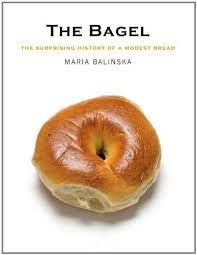The Bagel: The Surprising History of a Modest Bread
This book by Maria Balinska (2008) is, as the title states, about bagels. Why was I interested in reading about such a seemingly ‘modest’ food item as the bagel?
First,
I am a born and bred New Yorker, and fresh bagels from a bagel bakery had
always been a part of my personal cuisine. Since living in other countries and
travelling through other continents, however, I haven’t been able to find
anything similar to a New York bagel. Either there is no equivalent at all or an
item referred to as a bagel is merely a white roll with a hole. No comparison.
However, I have been in places that claim to be the ‘birthplace’ of the bagel,
but – curiously – they don’t sell anything resembling it now.
Second,
I am interested in the history of food and of foods. For example, I’ve read
about chocolate, olives, olive oil, food in prehistory, beer, salt – but I was
excited to find a book about the bagel. There are many myths surrounding its
creation, so I thought I would find out the truth in this book. But I’m not so
sure that I have. This is a very light read compared to other books I’ve read
about the history of a food item, but perhaps that’s because there’s not much
of a history to bagels or not much information to research. I’m still not sure
about the origin of the bagel known in New York.
Balinska
starts out referring to the obwarzanek
in Poland and the tarallo in Italy – which
are both small round breads with a hole. And then there’s a chapter on the
Polish Jewish immigrants to New York City who baked bagels. But it’s not clear
how the earlier breads evolved into the type known in New York today (or the
type known in Montreal, which I hadn’t known about).
The
story continues in New York: how the bagel was sold and what the life of the
bakers and sellers was like. Later chapters detailing how the bagel became
known in different areas of the United States and how it became a
mass-produced, frozen item sold in supermarkets across the USA is also
intriguing.
Much
of the information in chapter 6, though, is more about bakers than about the
bagel. It focuses on the bagel bakers’ union Local 338 in New York and its
fight for better pay and conditions – there was nothing about the bagel itself,
except for how it was becoming better known to non-Jewish Americans outside of
New York. But that theme is also in the following chapter.
Balinska
seems to have done quite a lot of research for this book. There are notes for
each chapter detailing her sources, and the ‘Further Reading’ section is “a
selection of those specialist books in English which [she] found particularly useful and often
thought-provoking.” Since none of these books is specifically about the bagel
(example sections on the list: On food, bread
and Jewish cooking; Jewish history in America, particularly New York; The
sociology of consumption and the food business in America), she must have
pored over many sources to extract the information specific to the bagel.
Overall, it was a
very interesting read with a lot of information about the bagel that I hadn’t
known before. But I still wish I could find a good bagel when I’m not in New
York.

Comments
Post a Comment